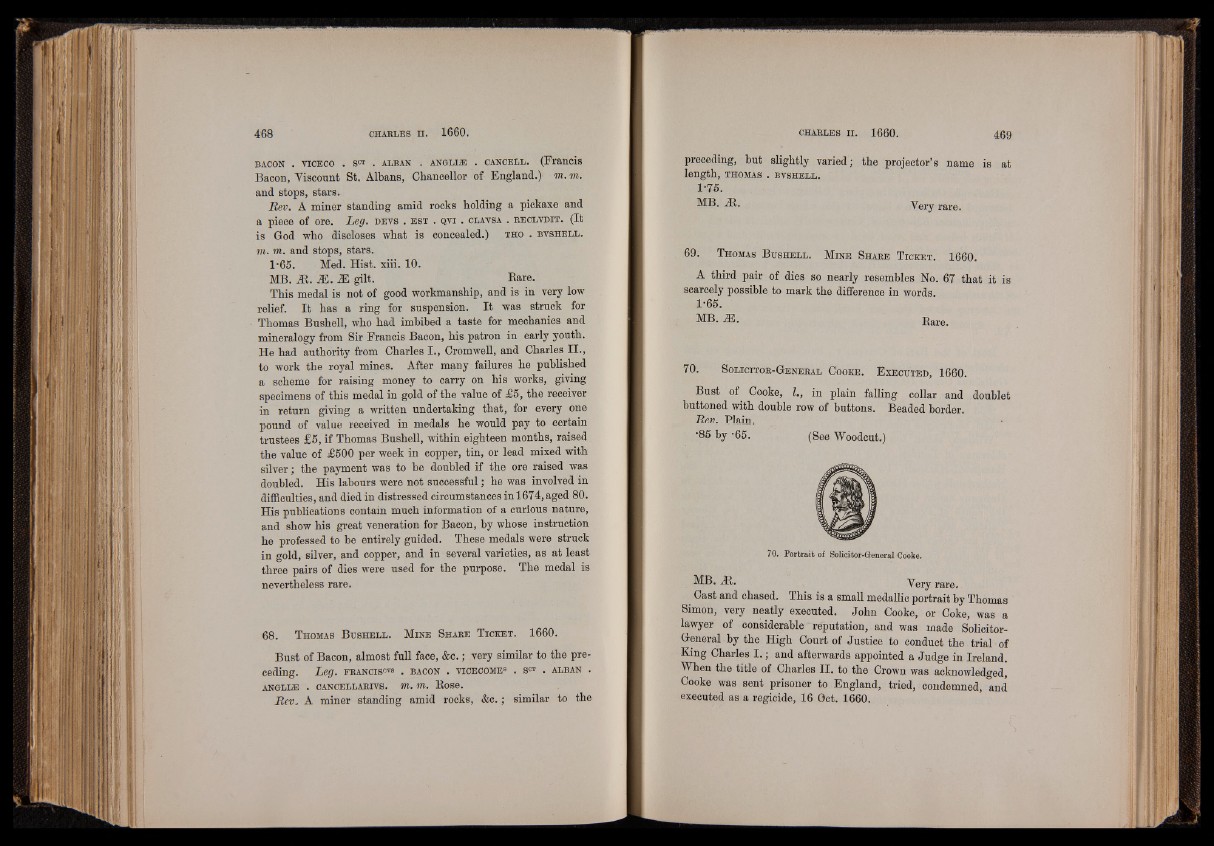
BACON . VICECO . SCT . ALBAN . ANGLIXE . CANCELL. (Francis
Bacon, Yiscount St. Albans, Chancellor of England.) m. m.
and stops, stars.
Rev. A miner standing amid rocks holding a pickaxe and
a piece of ore. Leg. d ev s . e s t . q v i . clavsa . b e c l v d it . (It
is God who discloses what is concealed.) t h o . b v s h e l l .
m. m. and stops, stars.
1-65. Med. Hist. xiii. 10.
MB. At. M. M gilt. Rare.
This medal is not of good workmanship, and is in very low
relief. I t has a ring for suspension. It was struck for
Thomas Bushell, who had imbibed a taste for mechanics and
mineralogy from Sir Francis Bacon, his patron in early youth.
He had authority from Charles T | Cromwell, and Charles II.,
to work the royal mines. After many failures he published
a scheme for raising money to carry on his works, giving
specimens of this medal in gold of the value of £5, the receiver
in return giving a written undertaking that, for every one
pound of value received in medals he would pay to certain
trustees £5, if Thomas Bushell, within eighteen months, raised
the value of £500 per week in copper, tin, or lead mixed with
silver; the payment was to be doubled if the ore raised was
doubled. His labours were not successful; he was involved in
difficulties, and died in distressed circumstances in 1674, aged 80.
His publications contain much information of a curious nature,
and show his great veneration for Bacon, by whose instruction
he professed to be entirely guided. These medals were struck
in gold, silver, and copper, and in several varieties, as at least
three pairs of dies were used for the purpose. The medal is
nevertheless rare.
68. T homas B u s h e l l . M in e S h a b e T ic k e t . 1660.
Bust of Bacon, almost full face, &c.; very similar to the preceding.
Leg. FEANcisors . b a c o n . v ic e c o m e8 . S°T . a l b a n .
ANGLIiE . CANCELLABIVS. «1. m . Rose.
Rev. A miner standing amid rocks, &c.; similar to the
preceding, but slightly varied; the projector’s name is at
length, thom as . b v s h e l l .
1-75.
MB. At. Yery rare.
69. T homas B u s h e l l . M in e S h a b e T ic k e t . 1660.
A third pair of dies so nearly resembles No. 67 that it is
scarcely possible to mark the difference in words.
1-65.
MB. AS. Rare.
70. S o l ic it o b -G e n e b a l C o o k e . E x e c u t e d , 1660.
Bust of Cooke, I., in plain falling collar and doublet
buttoned with double row of buttons. Beaded border.
Rev. Plain.
•85 by "65. (See Woodcut.)
70. Portrait of Solicitor-Greneral Cooke.
-MB. At. Very rare.
Cast and chased. This is a small medallic portrait by Thomas
Simon, very neatly executed. John Cooke, or Coke, was a
lawyer of considerable reputation, and was made Solicitor-
General by the High Court of Justice to conduct the trial of
King Charles I . ; and afterwards appointed a Judge in Ireland.
When the title of Charles II. to the Crown was acknowledged,
Cooke was sent prisoner to England, tried, condemned, and
executed as a regicide, 16 Oct. 1660.